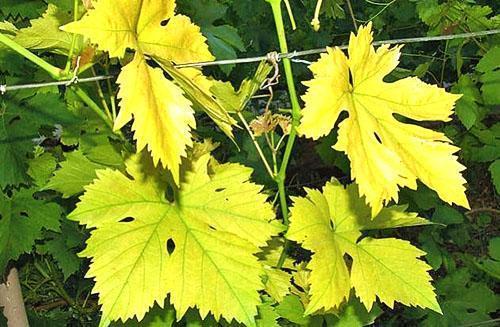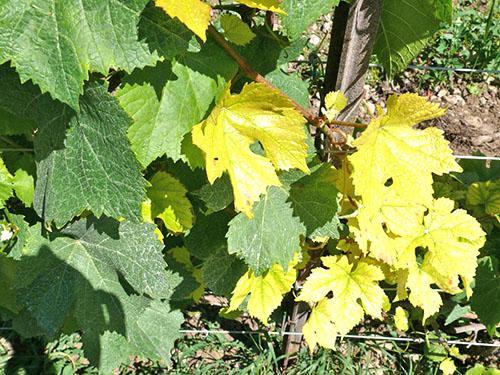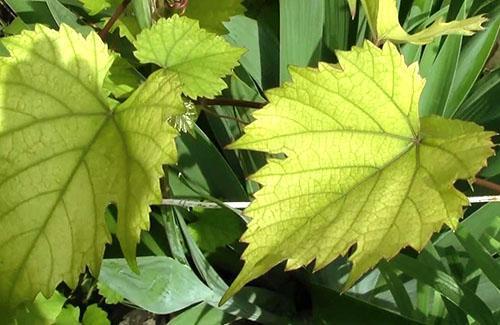Why do grape leaves turn light green
 Grapes, like any other plant, require sunlight, heat, water and nutrients that it receives from the soil for a full vegetation. With a lack of any of these components, all kinds of diseases appear in the plant. Let's talk about such a common phenomenon as lightening of grape leaves.
Grapes, like any other plant, require sunlight, heat, water and nutrients that it receives from the soil for a full vegetation. With a lack of any of these components, all kinds of diseases appear in the plant. Let's talk about such a common phenomenon as lightening of grape leaves.
Why do grapes have brighter leaves

There are many reasons for chlorosis of grapes:
- Lack of trace elements in the soil.
- Excess lime in the soil.
- Soil salinity.
- Fungal root diseases.
- Weather.
- Infectious diseases.
Cold and rainy weather is more conducive to chlorosis than dry and hot weather. With an increase in the amount of water in the soil, its aeration decreases. Plants suffer from a lack of oxygen, metabolic processes are disrupted in them, they stop branching and rot.
In addition, by dissolving lime in the soil, water can cause an alkaline reaction, in which the minerals necessary for the grapes are converted into insoluble compounds and carbonate chlorosis occurs in plants. You can compensate for the excess lime by introducing ammonium sulfate at the rate of 3 kg of the drug per 1 grape bush.
Fertilizers that cause an alkaline reaction should not be applied to the soil:
- Fresh manure (especially bird manure).
- Sodium and calcium nitrate compounds.
- Large portions superphosphate.
In areas with a high salt or carbonate composition of the soil, you can use grape seedlings grafted onto rootstocks that are resistant to these adverse factors.
Lack of minerals
 Today, about 70 microelements are known that are necessary for grapes for growth and development. A deficiency of some elements and an excess of others can lead to serious health problems for grape bushes and, as a consequence, loss of yield and even death of plants.
Today, about 70 microelements are known that are necessary for grapes for growth and development. A deficiency of some elements and an excess of others can lead to serious health problems for grape bushes and, as a consequence, loss of yield and even death of plants.
The light green color in grape leaves is often caused by a lack of minerals. Clarification of leaves can cause a lack of nitrogen, manganese, boron, zinc, molybdenum, iron in the soil.
Nitrogen is an element of growth. It is vital for plants, stimulating their growth and being a part of proteins. Nitrogen is in the soil in insoluble compounds and therefore is not available to plant roots. They receive active nitrogen mainly from organic humus, where this element is processed by soil bacteria into a soluble form. If there is not enough nitrogen in the soil, then the appearance of the plants immediately changes. The buds open slowly, the shoots are weak, without ovaries. On grapes, the lower leaves turn light green and their petioles red. Such leaves soon die off and fall off. Shoots become thin, with frequent internodes. Leaves and berries become smaller.
To meet the needs of grapes for nitrogen, in the spring, urea or a complex mineral fertilizer containing nitrogen should be distributed in the feeding zone of the bushes.
 Zinc affects the course of redox reactions in the plant organism, is involved in the conversion of carbohydrates. In addition, zinc is extremely important in nitrogen metabolism. With a lack of zinc, nitrogen accumulates in grape tissues, disrupting protein synthesis. At the same time, the leaves of the grapes lose their symmetry, become jagged, brittle, and become covered with light spots with a metallic sheen. Growth of shoots and brushes weakens. Lack of zinc in soil is a fairly common occurrence. Foliar treatments of grapes with a zinc oxide solution will help to correct the situation. A less effective remedy is adding zinc chelate to the soil.
Zinc affects the course of redox reactions in the plant organism, is involved in the conversion of carbohydrates. In addition, zinc is extremely important in nitrogen metabolism. With a lack of zinc, nitrogen accumulates in grape tissues, disrupting protein synthesis. At the same time, the leaves of the grapes lose their symmetry, become jagged, brittle, and become covered with light spots with a metallic sheen. Growth of shoots and brushes weakens. Lack of zinc in soil is a fairly common occurrence. Foliar treatments of grapes with a zinc oxide solution will help to correct the situation. A less effective remedy is adding zinc chelate to the soil.
 The trace element boron is responsible for the reproductive function of plants. With a lack of boron, the leaves of the grapes become mosaic discolored: in the intervals between the veins, the leaf tissue turns pale, then turns brown and dies. The edges of the leaves are curved outward. Clusters on grapes are either not tied at all, or tied loosely and fall off by the beginning of flowering, the growing point dies off. The roots weaken, which leads to winter freezing. To eliminate boron deficiency, foliar feeding with boron preparations is carried out.
The trace element boron is responsible for the reproductive function of plants. With a lack of boron, the leaves of the grapes become mosaic discolored: in the intervals between the veins, the leaf tissue turns pale, then turns brown and dies. The edges of the leaves are curved outward. Clusters on grapes are either not tied at all, or tied loosely and fall off by the beginning of flowering, the growing point dies off. The roots weaken, which leads to winter freezing. To eliminate boron deficiency, foliar feeding with boron preparations is carried out.
Very rarely, grapes may lack molybdenum. This deficiency makes its leaves pale and dull, turgor disappears in the leaves. Molybdenum is involved in water and nitrogen metabolism, affects the sugar content of grapes, its ability to root formation and wound healing. It is possible to compensate for the lack of molybdenum by applying fertilizers with this element, for example, molybdenum superphosphate, to the soil.
 The lack of manganese manifests itself similarly to the lack of the trace element boron. The leaves of the grapes first become spotty: they are covered with small light green specks. In the future, the light areas increase, merge, turn yellow and die off. Manganese is responsible for the regeneration of plant tissues, participates in photosynthesis and the formation of grape juice, and affects the absorption of nutrients. The deficiency is compensated for by foliar treatment with manganese sulfate.
The lack of manganese manifests itself similarly to the lack of the trace element boron. The leaves of the grapes first become spotty: they are covered with small light green specks. In the future, the light areas increase, merge, turn yellow and die off. Manganese is responsible for the regeneration of plant tissues, participates in photosynthesis and the formation of grape juice, and affects the absorption of nutrients. The deficiency is compensated for by foliar treatment with manganese sulfate.
Diseases of grapes and its treatment
 Clarification of grape leaves can also occur due to an infectious disease. Chlorosis is caused by the yellow (spotted) mosaic virus, which is carried in the soil by nematodes. The virus can also be present on low-quality planting material.
Clarification of grape leaves can also occur due to an infectious disease. Chlorosis is caused by the yellow (spotted) mosaic virus, which is carried in the soil by nematodes. The virus can also be present on low-quality planting material.
The main feature infectious chlorosis - first the veins turn yellow, and only then the sheet tissue. Either individual yellow spots appear on the leaf blades, or the yellowness begins to spread from the veins. Over time, the leaves turn brown, curl and dry out. A short node appears in the shoots - the nodes are located very often to each other, from which many stepsons with small leaves grow.
If the grapes are infected with the spotted mosaic virus, then it must be immediately uprooted and destroyed, otherwise there is a risk of infecting other plants (not only grapes). The soil in its place must be thoroughly disinfected against nematodes. Experts recommend growing crops in this place for disinfection up to 6 years that do not eat nematodes, for example, cereals.
In no case should you take cuttings from plants infected with yellow mosaic for propagation! The variety can only be restored with healthy planting material.
 Fungal pathogens can also cause disease in grapes. Its treatment consists in the timely treatment of plants with antifungal drugs. With a disease with powdery mildew (oidium) and downy mildew (mildew), the leaves of grapes are covered with yellow spots and ashy, mildew-like bloom. Light spots appear on the leaves under bloom. Powdery mildew outbreaks are facilitated by warm, humid weather in winter and spring. These diseases can completely ruin the crop.
Fungal pathogens can also cause disease in grapes. Its treatment consists in the timely treatment of plants with antifungal drugs. With a disease with powdery mildew (oidium) and downy mildew (mildew), the leaves of grapes are covered with yellow spots and ashy, mildew-like bloom. Light spots appear on the leaves under bloom. Powdery mildew outbreaks are facilitated by warm, humid weather in winter and spring. These diseases can completely ruin the crop.
Therefore, during the care of grapes in June, it is necessary to carry out three times treatment of the bushes with antifungal drugs - in the second, third and fourth ten days of the month. In parallel, bushes can also be treated against parasites. It is best to carry out the treatment in the evening, when the sun is no longer so hot. The leaves should be covered with mortar on both sides. After rain, it makes sense to process the vine bushes again.
Every year it is necessary to change drugs for antifungal treatment, so as not to cause resistance to them in pathogens.
How to sprinkle grapes? Fungucides (antifungal agents) can be prepared independently or you can use industrial solutions.
You can prepare the following drugs yourself:
- Bordeaux liquid. The mixture is prepared just before spraying. To obtain a 1% solution, 100 g of copper sulfate powder is poured with 5 liters of hot water. To increase the concentration of the solution for every 1%, you need to add 100 g of copper sulfate. For every 100 g of copper sulfate, take 75 g of quicklime and quench it in 5 liters of cold water. Then the lime is stirred well and filtered from the suspension. Continuing to stir, thinly pour in a solution of vitriol. The reaction of the solution should be slightly alkaline or neutral. If the acidity was high, lime should be added. The preparation can be mixed with sulfur before processing.
- California liquid (lime-sulfuric broth). For 17 parts of water, take 1 part of quicklime and 2 parts of sulfur. Sulfur is kneaded in the form of a dough, and lime is quenched in the rest of the water. Then everything is mixed and cooked for 1 hour.
Do not inhale the vapors of the hot preparation, as this can damage the respiratory organs! The result is a dark red liquid. The solution is diluted with water before processing.
- Aqueous solutions of colloidal sulfur and ferrous sulfate.
There is a fairly wide selection of industrial preparations: Ridomil, Mankotseb, Acrobat MC, Ditan M-24, Rapid Gold, Acidan, Kuprikol, Ordan, Tsikhom, Topaz, Poliram, Alirin-B, Planriz, Fundazol.
 Top dressing of grapes with ash is very effective. It can be applied both to the soil and used for foliar treatments. Ash is a good source of potassium and phosphorus and has anti-fungal properties.
Top dressing of grapes with ash is very effective. It can be applied both to the soil and used for foliar treatments. Ash is a good source of potassium and phosphorus and has anti-fungal properties.
 For foliar top dressing, soak 1 liter of ash in 2 liters of water and leave for 3 days. Then add another 4 liters of water, after which the mixture is ready to use. When applying ash to the soil, it must be dug into the grooves around the vines. In autumn, the bushes can be poured with an ash solution (200 g per bucket of water), after pouring 3 buckets of water under each bush.
For foliar top dressing, soak 1 liter of ash in 2 liters of water and leave for 3 days. Then add another 4 liters of water, after which the mixture is ready to use. When applying ash to the soil, it must be dug into the grooves around the vines. In autumn, the bushes can be poured with an ash solution (200 g per bucket of water), after pouring 3 buckets of water under each bush.
In order for your vineyard to be healthy and delight you with an excellent harvest, no diseases, especially infectious ones, should be allowed into it. And the first cry for help can be just the light green color of grape leaves.